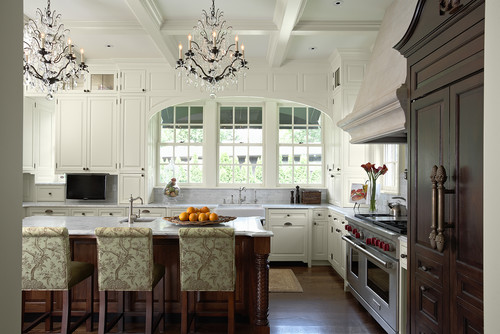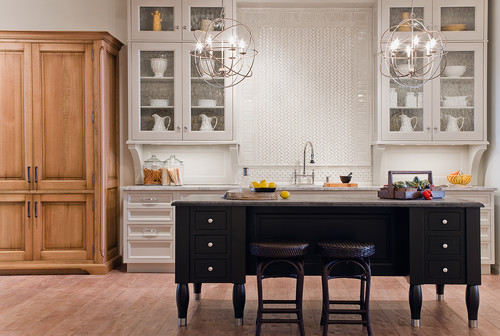Traditional Kitchen designs – what to include
Traditional kitchens where modern convenience meets old world charm and style
Adapted from and Article on HOUZZ
Traditional kitchens are defined by their details, and creating eye-catching detail is not just as simple as putting legs on an island. But whether they’re Old World or Mediterranean flavour, traditional kitchens all share the same basic elements. Here are 11 details that help you create traditional kitchen style.
1. Architectural details. Traditional kitchens focus on the details in all areas. There’s a bit of embellishment or adornment everywhere you look. Here it is true that more is more. However, the best traditional kitchens just feel layered rather than overbearing. Here’s where you need to seek help from your designer so that you don’t either overdo it or under do it.
Speaking of details, this above kitchen has it all — arches, mouldings, beam ceilings, framed and raised-panel cabinets, a custom hood surround, chandeliers, furniture-style cabinets and, of course, island legs. Note how each area has detailing: the island’s turned legs, the dark panelled wood piece in the front that hides the fridge, and the shape and moulding of the custom hood surround. I personally like the TV screen on the back wall that is part of the design too. New meets old!
2. Glazed and antique cabinet finishes. Traditional kitchens often feature cabinet finishes that are glazed or made to look aged and distressed. Whether you’re using antique white or a colour like the island shown, a bit of glazing can add instant age and patina. Be careful, though. Some antique finishes look fake, so make sure your cabinetmaker has samples for you to approve before ordering.
Traditional kitchen designs often use multiple finishes. Sometimes you’ll see one colour or style cabinet on the perimeter and another on the island, for example. Feel free to mix in a tall cabinet with a natural stained-wood tone. Even a section of cabinets?
3. Raised-panel doors. Traditional kitchen designs have more ornamentation than transitional or modern kitchens. Raised-panel doors come in many different styles, and the shadow lines created by this extra detail are a signature look of traditional kitchens. Check with your cabinetmaker regarding the options, but generally the sky is the limit. Make sure your cabinet make shows you pictures of cabinetry he has actually done himself. “Well done” is so much more powerful than “well said”.
4. Decorative mouldings and corbels and door inserts. In keeping with the idea that more is more, you can add also ornamentation with carved corbels or brackets and applied moulding between cabinets. . For doors, there are limitless detail options for cabinets in a traditional kitchen: glass with a bevelled outside edge, antique glass, wood mullions in dozens of different arrangements or metal mesh inserts as shown in this kitchen. Some traditional kitchens even employ different options in different sections
5. Architectural details for cabinetry. In this kitchen you’ll see legs on the sink-wall base cabinets in addition to an architectural surround that really draws your eye to that focal point. You may also note that the sink’s base cabinets are a different depth than the cabinets on either side — these undulating depths add visual interest. Traditional kitchens employ details like legs and pilasters on islands, furniture-style toe kicks that make the cabinets look like they’re freestanding, and custom wood hood surrounds that sometimes look like fireplace surrounds. All of these details layer on top of one other to make a traditional kitchen go the full distance.
6. Apron-front sinks or “butlers sinks” are another signature element of traditional kitchen design, though these are pretty popular in classic kitchens as well. They are a beautiful old world touch and usually are deep and generous. Be careful washing out your pots in them so you don’t chip the porcelain surfaces.
7. Luxury countertop materials. Calacatta and Carrara marble, quartzite and light granites are all popular choices for traditional kitchen countertops. Even though marble is a more high-maintenance choice, it has an Old World feel that keeps drawing people back to it. There are also lots of manmade quartz materials that simulate the look of marble and limestone if you want something easier to deal with. In Australia, Ceasarstone and other man made brands are popular. Make them look traditional by changing the edge profile.
8. Ornate and decorative lighting. Traditional kitchen designs boast crystal or brass chandeliers, lantern-style lights — generally speaking, lighting that you might expect to see in a dining room more than a kitchen.
9. Custom metal, plaster and stone hoods. As an alternative to wood hood surrounds and fireplace-style hoods, traditional kitchens often feature ornate metal hoods, custom-shaped plaster hoods with mouldings and corbels, and even carved stone hoods.
A plaster hood is often just as ornate, but it’s less heavy than wood. This style also works great when you don’t have wood cabinets flanking the hood to tie the hood into, because the plaster hood stands on its own better.
10. Splashback niches and ledges. Going that extra step with small, unexpected details is what makes a traditional kitchen feel the way it feels. Niches behind the stove are one such detail. Tiles, especially handmade white tiles are a traditional kitchen trademark.
11. Furniture-style tall cabinets. Cabinets that don’t look like cabinets are a big hit in traditional kitchens. The stained wood cabinet on the left could be hiding the pantry or the refrigerator.
Ready to get you traditional kitchen design started? Call us on 1300 662 838 to speak with one of our award winning designers or get our inspiration guide for more renovation ideas and advices.
Inspiration and advice
Inspiration and advice
As featured in










